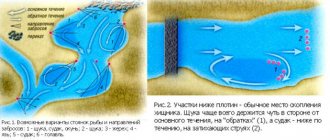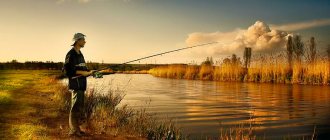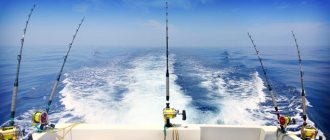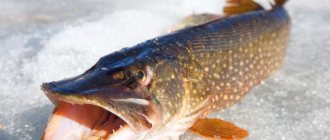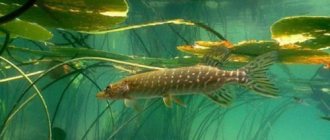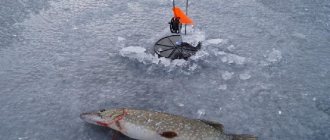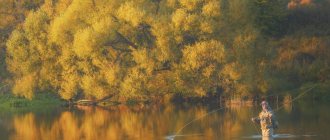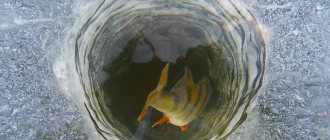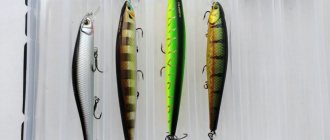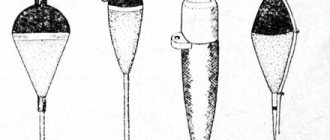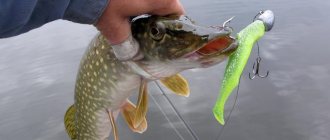Catching pike in a pond is somewhat different from catching a predator on a river or lake, and here's why. A pond, if we consider it as a reservoir with its own hydrological scheme, differs from reservoirs with a current and from reservoirs without a current.
Unlike a lake, on a pond there is always a current, albeit a small one, from the confluence of the dammed river to the discharge through the dam of the pond.
A pond differs from a river in that in the bulk of the pond there is no current, with the exception of wind. The main movement of water occurs along the flooded bed of a dammed river or stream, and irrigation is practically completely stationary.
Small pike hunt in the overgrown irrigation areas along the banks of the pond.
Such an interesting hydrological scheme leaves an imprint on the life and behavior of all the inhabitants of the pond, including the predatory fish that live in it.
Further, as for predatory fish, and in particular pike. The pike in the pond is the top predator. There are no catfish here that could pose a danger to her. The only natural enemies of pike in the pond are perch and rotan, which can eat pike eggs after spawning, thereby reducing the pike population.
Also, the pike in the pond does not experience food competition with pike perch, since pike perch is not found in the pond, the conditions are not suitable for it - the oxygen regime and flow in the pond are not suitable for it, as well as the structure of the bottom.
Frog
One of the best ways to catch pike is with frog baits. Today they produce a number of different options. They are made of environmentally friendly material and will not pick up pests from weeds or get entangled in them thanks to their thoughtful design and ideal tilt angle adjustment. These pike fishing lures are highly regarded for their durability and effectiveness.
Line for spinning pike fishing
I would recommend PowerPro 0.15. Universal, inexpensive. The length is at least 150 yards, 90 yards will quickly end in the process of breaks. It is possible to use low-stretch monofilament 0.22-0.25, I prefer Suffix, I would prefer braid to more expensive Shimano monofilaments.
Leashes, carbines.
For spinners and jigs, any normal quality leash is suitable, with the exception of fishing with a twister without a load and a Carolina rig - here you need a lighter leash about 10 cm long. Personally, I prefer carabiners and leashes with a breaking load of at least 20 kg, because in fact, they often break much earlier.
Time of year and time of day
You can catch pike at almost any time of the year, but it is important to know what gear to use during the season. In spring, pike usually live in sandy areas of rivers and streams, since this is where they are born, and they like to hide near the shore in safe reeds or in shallow water. As the weather gets warmer and weeds and vegetation grow, pike tend to move further from their birthplace and more towards the center of the body of water. In autumn, pike often live in the depths.
It is not always important which baits are chosen for fishing; the time of day also plays a role. It is important to know that pike do not eat in the dark, so the best time to catch it is early in the morning at dawn. Large baits work very effectively at this time as calm water attracts larger fish to the bait. After early morning exercise, pike allows you to simply relax, and at this time fishing is not very effective. Since these predators do not eat at night, they prefer to eat shortly before sunset. Therefore, fishing at sunset can bring a good catch.
When to catch pike in a pond
The best time to catch pond pike is in the spring immediately after the ice melts and in early summer after spawning. In spring, the ice from the pond melts very slowly; after irrigation, the ice can linger until the end of April.
However, the place where the river flows into the pond is revealed very early. Already in mid-March you can catch pike here with a spinning rod. Due to the fact that this place is very local, the concentration of predators here is high.
At the beginning of summer, the best time for fishing is along the channel edges of a flooded river. The grass is not rising much yet and the water in the pond has not yet had time to warm up much.
And closer to October, the predator moves to the deepest place of the pond - to the dam. Here it can be caught using jig baits and heavy oscillating spoons. Often there are submerged logs and driftwood lying underneath the dam itself. These are where the fattest pike “mothers” live, which can only be obtained from there with the help of Texas equipment.
At the beginning of autumn, you can start catching pike from the pond dam using jigs, spoons and weighted spinners.
Another feature is the complete absence of bites from the pond predator during the hot summer months. Catching pike in July with a spinning rod on a pond using artificial bait is futile. The local population, if they are not fishing for predators with nets, catch pike in the pond with live bait, setting up stands - summer perches under bushes near the dam and along the flooded river bed.
More on this topic on our website:
- Pike in the spring for spinning - choose the time, place and bait After the ice has melted from the river beds, you can begin the spinning season in open water. There are many places in Russia where…
- Pike on a popper - where and how to catch As soon as the water warms up enough, which happens in the vast expanses of Russian reservoirs closer to June, you can start catching the predator using surface...
- Pike in troubled water - behavior, bait, how to catch There is a saying “Fishing in troubled water.” To those who hear it, it seems that this is a very profitable and easy activity...
- Pike in December - catching pike with spoons Well, colleagues, the deputy comes into its own, and pike in December becomes as desirable a trophy as pike perch in the spring...
Which type and which baits are better
The reason so many different types of bait work for pike is because they eat a lot of things. Wobblers cause movement in the water, which can be very attractive to pike. Spoons can also be of interest due to their movement, but are usually used to catch smaller specimens. Floating lures are great for shallow water and brush. It is important to purchase high-quality fishing line for pike - after all, this fish is not only large in size, but can actively resist. The fishing line must be strong, and its color depends on the color of the water in which the fish lives.
About
Spinning rod for pike fishing
For coastal fishing on small rivers up to 50-70m wide, a spinning rod 2.4 m long, with a dough from 5-7 to about 25 grams, is quite suitable, this is a classic option. I don’t recommend taking it shorter. Of the budget initial options, I would first of all mention Kola Spinnig 2.4 m 5-25 g. Due to its sufficient rigidity, it is perfect for fishing with spoons; it can be used to guide small wobblers, poppers; jig wiring is possible, but not very convenient. Salmo spinning rods are a good starting option, however, Salmo jig spinning rods with a length of 2.4 m are perfect for spinners and initial jig fishing, but there will be big problems with wiring wobblers and poppers on them, because their softness does not allow jerking. That. more rigid (not to be confused with high test) spinning rods will be more versatile and better for initial fishing. I didn’t really like the Mikado spinning rods; they have rather thin walls and, as a result, they break quickly. You should also be careful about the Norstream spinning rods, which were widely advertised at one time - for some time they were recommended to everyone on the forums, and after half a year, many used spinning rods from this company were put up for sale, my friend also bought a Norstream speaker - he didn’t like it .
I wouldn’t immediately buy more expensive spinning rods; this is due to the fact that at the initial stage it is very difficult to determine what qualities and properties you want from a spinning rod, and what kind of fishing you will focus on. Leave the purchase of a more expensive and highly specialized spinning rod for later; if you like wobblers, you will need one spinning rod; if you like jig fishing on the Don, you will need a completely different one. Fish an inexpensive spinning rod - it will become the reference point against which you will search, maybe lighter, maybe tougher, longer or with a different test.
What size bait is best
The size of your bait should match the size of the pike you want to catch. If you fish in shallow water where there are a lot of weeds, you will most likely only be able to catch smaller pike. The time of year and time of day must be taken into account.
Fishing for pike is a very pleasant and rewarding activity, but if you take the wrong type of bait, the fishing may not take place. In the spring, pike usually stay close to shore before moving further out during the year. They don't feed at night, so the best times to fish are sunrise and sunset, although you can try throughout the day. Pike can also be aggressive with sharp teeth, so it's worth getting a strong fishing line.
Views: 1,195
Reel for spinning pike fishing
Any good quality reel will do, line capacity 2500 according to the Shimano classification with a metal spool (required for using braid). A classic would be Shimano nexave 2500; if there is a question of saving money, then Shimano alivia, but it creates scuffs on the spool much faster and easier, spoiling the fishing line. For inexpensive reels, you can buy something like the Mikado crystal line - a reliable reel that is resistant to poor operating conditions, but this reel has the disadvantage of beating on the sides when winding, which greatly spoils the impression of it. Pay attention to Okuma coils.
You shouldn’t chase too much for the number of bearings; 2-3 are enough to start with. An endless screw is needed primarily for jerk fishing with wobblers; such a reel should be purchased in the process of mastering wobbler fishing and when specializing specifically in wobblers. For jigs and spinners, you don't need an endless spinner.
If we talk about better quality infinity reels, then, in addition to the well-known and well-known Shimano and Daiwa, I advise you to pay attention to the SPRO BlueArc and blakc arc reels
Trolling for pike
Currently, in Russia, a variety of methods are used to catch pike, allowing the lure to be cast from a moving boat. Trolling is rightfully considered the most popular and popular method in this case.
Trolling locations
Trolling as an effective way of catching pike is relevant in large bodies of water, such as large lakes and reservoirs. Fishing by trolling is effective in open water, where large spaces facilitate the feeding of large fish. Actually, where large fish gather in large schools, there is a real opportunity to catch a seasoned pike. Fishermen from Scandinavian countries have succeeded in pike fishing. There, such fish are caught mainly in numerous bays, fjords and channels. A lot of mature pike are found in desalinated areas of the Baltic Sea (coastal waters of Finland and Sweden). As the season begins, the coastline along Finnish and Swedish settlements is literally overflowing with boats and boats equipped with trolling gear.
On the territory of the Russian Federation, the Gorky and Rybinsk reservoirs, Lakes Ladoga and Onega and most reservoirs of Karelia are considered the most preferable for pike fishing. Choosing a place for trolling is not difficult: you need to find an unsnagged reservoir with a depth of at least 2 meters. Reservoirs that are too deep are practically unsuitable for catching pike by trolling with wobblers, so the depth of the reservoir should not exceed 7 meters.
Choosing a motor for trolling
The correct choice of outboard motor is a very important point, on which the fishing result largely depends. Taking into account that trolling is fishing with the simultaneous use of several rods, low-noise motors, mainly foreign-made, are used to ensure quiet running when retrieving. When trolling, it is preferable to use gasoline or electric motors powered by an appropriate battery. Today, American and Japanese-made engines are especially popular among domestic fishermen. As a rule, these are power plants with power ranging from 20 to 200 l/s. The selection of the engine is carried out in accordance with the type and dimensions of the boat, or, conversely, the boat is selected in accordance with the type of the existing engine. As an example, we note that the popular “Kazanka” is equipped with an engine with a power of no more than 30 l/s.
Optional equipment
As additional equipment, it is worth noting such, sometimes irreplaceable devices as an echo sounder and a navigator. An echo sounder allows you to promptly detect uneven terrain and avoid getting your gear stuck or tangled. An equally necessary device is a navigator, which is capable of determining the coordinates of the boat on a zoomable map. Thanks to this device, you can record your location and continue the route from or to the starting point. Again, an important detail: there are boats that are optionally equipped with a rod holder. If such devices are not available, they should be purchased. At the moment, holders are usually produced in two main designs - grips and sockets. Which of the two types of holders is better is up to you to choose, since it all depends on the experience, dexterity and personal preferences of the fisherman.
Trolling gear
Trolling is a unique type of fishing in its own way, and therefore it involves the use of special gear. A very important point for effective fishing is the correct selection of a fishing rod. Most often this is a device with a length of 1.8 - 2.7 meters. Equally important is the correct selection of fishing line, since the success and effectiveness of fishing depends on it. Currently, braided fishing line (braid) with a cross-sectional diameter of 0.18 - 0.25 mm is widely used. The use of high-test braided fishing line is explained by the possibility of emergency braking in the event of an unexpected snag. In these cases, the use of thin lines is not advisable, since they quickly break. In addition to the rod and lines, effective pike fishing requires outriggers, downriggers and paravanes.
An outrigger is a device that allows you to respond in a timely manner to a bite or provide control in the event of a fish hooking itself. Moreover, the outrigger significantly reduces the load on the spinning rod. An outrigger is a small structure mounted on a fishing rod near the handle. A fishing line is inserted into the device, the stroke of which is adjusted using a clamping screw.
Downriggers are devices for deepening and guiding bait at the required depth. In the post-Soviet space, this type of device appeared relatively recently, but has already become popular among domestic fishermen - amateurs and professionals.
Guaranteed success in pike fishing depends on the correct selection of bait. The bait is selected according to the type of fish and season. In summer, medium and large wobblers, as well as medium and large vibrotails, are used. In autumn, approximately the same baits are used as in summer, but in addition, soft bait mounted on heavy jig heads can be used.
Bottom method of fishing for pike with live bait
The following proposed method of fishing for pike is applicable only for fishing with live bait, since the hooks are installed in opposite directions from each other. One hook must be passed through the lip of the bait fish, and the second hook must be pierced through its back near the fin. Having thrown such bait, as a rule, it will immediately swim to the bottom of the reservoir in order to hide there, where the pike will find it.
Of course, this method of fishing for predatory fish is the most complex and requires constant and careful control from the angler. It should not be used in areas of the reservoir with abundant thickets of algae and other vegetation. Also, sometimes it is very difficult to wait until the released bait stops completely in order to activate the installed bite alarm.
After this, it remains to tirelessly monitor the bite alarm when its indicator begins to fall back. This is certainly difficult and requires a lot of patience, but this method of fishing for pike allows you to catch the largest specimens.
Catching pike on a donk
What is a donka with an elastic band designed for catching pikes? These are scaffolding with a diameter of 0.8-1.0 mm and a length of 25-30 m, with two to three loops in which metal leashes with tees are attached. A rubber shock absorber 4-5 m long is tied to the far end of the scaffolding, with a small cord and a lead weight (a stone, a piece of brick). It is difficult to throw such a donkey completely into the water: leashes with tees tangle the tackle. Therefore, I only throw a stone with an elastic band and line. After that, I pull out the line, secure it to a peg driven in at the very edge of the water, and, connecting metal leashes with tees and live bait attached to them to the line, I release them one by one into the water. A tightly stretched elastic band drags them to the bottom of the bayou. It is not advisable to place more than two or three leashes on the forest. After all, if there is a pike on at least one tee and begins to rush about, then no predator will approach the live bait remaining on the other hooks. However, sometimes two small pike can be caught on one donk, but extremely rarely. This only happened to me once. So it’s better to equip the tackle with two or three tees, but you can put 3-5 donks in different places of the oxbow lake without the risk of being accused of violating the rules of amateur fishing.
The best live baits are minnows, crucians, and perches. Probably roach, rudd, dace, bleak, ruffe, loach, and loach are also suitable, but I have not tried. You can catch pike on a donka from the opening of the summer season until freeze-up. As for the time of day, in the summer it bites well in the mornings and evenings, in the fall - all day. During the time of intense biting, checking the bottoms, you can see how the line moves from side to side. The pike took the bait! With excitement you take the line and cut. The fish responds with a heavy push, pulls into the depths, or even gives a “candle”, flying out of the water with an open mouth, protruding gills, and a tail bent into an arc. Then quickly take the landing net and carefully place it under the pike’s belly.
The success of fishing largely depends on the skillful choice of location. It happened that during a week of active fishing there was not a single bite on a particular donkey. On the other hand, we caught pike almost every day. The deep sections of the oxbow lake turned out to be promising. They are usually located at a higher shore. It’s good if a tree felled by a storm or beavers goes from the shore into the water. The pike finds reliable shelter under its trunk and branches. Small bays also attract predators. It is useless to place a donk in shallow places, if only because the squirrels will certainly take the bait. More than once I had to watch how a tiny, pencil-sized little bee, clinging to a gudgeon, drags it close to the surface and does not let go of its mouth even when you begin to pull the donkey ashore. If it unhooks at the water's edge, it does not go far and again attacks the baitfish as soon as the elastic band pulls it into the water.
For a donkey with an elastic band, you need an exceptionally strong main scaffold. This is the story that happened to me one day. I checked one of the donkeys in the morning and was surprised to see a ball of fishing line with a small piece of elastic and metal leads and tees stretching out of the water. What does it mean? Has anyone else, besides me, begun to bet donks on this oxbow? If this is so, then how did someone else’s tackle end up wrapped around my donk? I put on my glasses. It’s like a familiar forest, and the loops are the same as the ones I usually tie, and the leashes and tees seem to come from my bag. There are no more doubts - my donka! And I immediately remembered that three days ago, about a hundred meters from this place, I pulled onto the shore instead of a donkey just a piece of fishing line. It was necessary to use a millimeter one, but I was hoping for 0.6 mm. Under the pressure of the pike, the forest broke - at the knot of one of the loops. And now, three days later, the donka is in my hands - in the form of a ball of fishing line. Of course, there is no pike. And it was, apparently, not small, judging by the torn line with a diameter of 0.6 mm.
Another feature that needs to be taken into account. Hooks lose strength from prolonged exposure to water. One day, coming to a pond, a fisherman will find a “double” instead of a tee. And don’t think that this was done by a large fish. It is enough to squeeze the remaining hooks tightly with your fingers - they will break off with a slight crunch. This happened to me too. Therefore, from time to time (every two to three weeks) I replace rusted tees with new ones. Perches are often caught on the bottom. On “my” oxbow lakes they are no more than 100-150g. You wonder how they manage to swallow a tee with a minnow. Perch on a hook is less tenacious than pike, so donkeys have to be checked more often.
Catching pike with a float rod
Pike bite well regardless of the time of day, but any body of water has its own special biting hours. Basically, large individuals prefer to feed in the morning, and if the weather is windy then closer to noon. Cloudy days with light rain usually bring success. This fishing method is suitable for lakes, reservoirs, ponds and rivers with a quiet current. The rods should have a strong bending end and considerable length, with a line diameter of 0.4-0.5 mm. The float can be made of cork, polystyrene foam or bark in the shape of an egg and of a size capable of holding live bait and sinkers. You also need a hook (tee, double, single) No. 5-10 with a special nozzle and a metal leash. The rod does not have to be long, and sometimes short, if it has guides, a reel and a float necessary for long casts. Live bait, of course, is the best bait; ruff, char, crucian carp, and loach are suitable for its role. Live bait is placed 50-60 cm from the bottom (higher is possible). It is attached by the sponge or the back, sometimes by the tail. When using a double, you can place two minnows or loaches on it. For more effective fishing, you can use two hooks, the first is passed through the gills and secured to the lip, the second is immediately attached to the back. This will make it possible to hook the pike immediately, as soon as the float is hidden under the water, and there is no need to wait for the bait to be completely swallowed. Pike often do not swallow their prey immediately, but hold it in their teeth for some time. When fishing with tees or doubles, fishermen do not rush to hook, but wait until the pike swallows its false prey. A float rod is great for catching these fish directly from a boat at depth. The live bait is attached to the back with two single hooks, as described above, or to a tee.
